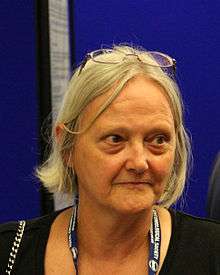Janet Hemingway
| Janet Hemingway | |
|---|---|
 Hemingway at the Xth European Congress of Entomology, York, 2014 | |
| Born |
June 13, 1957[1] West Yorkshire |
| Fields | |
| Institutions | Liverpool School of Tropical Medicine |
| Alma mater | |
| Thesis | Genetics and biochemistry of insecticide resistance in Anophelines (1981) |
| Notable awards | |
|
Website http://www.lstmliverpool.ac.uk/research/departments/staff-profiles/janet-hemingway | |
Janet Hemingway, CBE FRS[2] FMedSci FRCP (born 1957)[1][3] is a British parasitologist, Professor of Insect Molecular Biology and Director of the Liverpool School of Tropical Medicine (LSTM). She also works on advocacy and resource mobilization (and was previously chief executive officer) at the Innovative Vector Control Consortium (IVCC) (funded by the Bill and Melinda Gates Foundation),[4] and is International Director of the Joint Centre for Infectious Diseases Research, Jizan, Saudi Arabia.[5] She is "the youngest woman to ever to become a full professor in the UK".[5]
Early life and education
Hemingway was born in a small mining town in West Yorkshire in 1957[1] to parents who owned a corner shop. She obtained a first-class honours degree in zoology and genetics from the University of Sheffield, where she set up the university's first mosquito insectary as part of her thesis project. She was invited to pursue a PhD at the London School of Hygiene and Tropical Medicine (LSHTM), and within two years had obtained her doctorate on the biochemistry and genetics of insecticide resistance in Anopheles mosquitoes.[3][6][7]
Research
Hemingway has 30 years of experience working on the biochemistry and molecular biology of specific enzyme systems associated with xenobiotic resistance, most notably the malaria-transmitting mosquito.[8][9][10][11][12]
Awards and honours
- Awarded Commander of the Order of the British Empire (CBE) for services to the Control of Tropical Disease Vectors in the Queen's 2012 Birthday Honours.[13]
- Inaugurated as a Fellow of The Royal Society (FRS) in 2011.[2]
- Elected as a Fellow to the American Academy of Microbiology in 2011.
- Elected as a Foreign Associate to the United States National Academy of Sciences in 2010.[3]
- Conferred Honorary Doctor of Science by University of Sheffield in 2009.
- Inaugurated as a Fellow of the Royal College of Physicians in 2008.
- Inaugurated as a Fellow of the Academy of Medical Sciences (FMedSci) in 2006.
Her nomination for the Royal Society reads
| “ | Janet Hemingway is distinguished as the international authority on insecticide resistance in insect vectors of disease. She was first to report co-amplification of multiple genes on a single amplicon and demonstrate their impact on disease transmission. Her studies on resistance management have transformed the use of insecticide by disease control programmes. Her promotion of evidence-based monitoring and evaluation strategies for insecticide resistance has guided and improved international policy on vector control strategies for Onchocerciasis, Malaria, and other vector borne diseases. Her rigorous scientific approach to resistance analysis has contributed to a greater understanding of resistance, its impact and spread and has minimised its effect in increasing human mortality and morbidity.[2] | ” |
References
- 1 2 3 "HEMINGWAY, Prof. Janet". Who's Who 2014, A & C Black, an imprint of Bloomsbury Publishing plc, 2014; online edn, Oxford University Press.(subscription required)
- 1 2 3 4 "Professor Janet Hemingway FRS". Retrieved 11 October 2013.
- 1 2 3 Griswold, Ann (2013). "Profile of Janet Hemingway". Proceedings of the National Academy of Sciences. 110 (14): 5276–5278. doi:10.1073/pnas.1302101110. PMC 3619356
 . PMID 23440199.
. PMID 23440199. - ↑ "Prof Janet Hemingway".
- 1 2 Janet Hemingway, The Life Scientific 2014-06-10 BBC Radio 4
- ↑ Hemingway, Janet (1981). Genetics and biochemistry of insecticide resistance in Anophelines (PhD thesis). London School of Hygiene and Tropical Medicine (University of London).
- ↑ Ranson, H.; Jensen, B.; Vulule, J. M.; Wang, X.; Hemingway, J.; Collins, F. H. (2000). "Identification of a point mutation in the voltage-gated sodium channel gene of Kenyan Anopheles gambiae associated with resistance to DDT and pyrethroids". Insect Molecular Biology. 9 (5): 491–7. doi:10.1046/j.1365-2583.2000.00209.x. PMID 11029667.
- ↑ Hemingway, J.; Ranson, H. (2000). "Insecticide Resistance in Insect Vectors of Human Disease". Annual Review of Entomology. 45: 371–91. doi:10.1146/annurev.ento.45.1.371. PMID 10761582.
- ↑ Vaughan, A; Hawkes, N; Hemingway, J (1997). "Co-amplification explains linkage disequilibrium of two mosquito esterase genes in insecticide-resistant Culex quinquefasciatus". The Biochemical Journal. 325 (2): 359–65. doi:10.1042/bj3250359. PMC 1218568
 . PMID 9230114.
. PMID 9230114. - ↑ McCarroll, L; Hemingway, J (2002). "Can insecticide resistance status affect parasite transmission in mosquitoes?". Insect biochemistry and molecular biology. 32 (10): 1345–51. doi:10.1016/s0965-1748(02)00097-8. PMID 12225925.
- ↑ Janet Hemingway's publications indexed by the Scopus bibliographic database, a service provided by Elsevier. (subscription required)
- ↑ Hemingway, J.; Hawkes, N. J.; McCarroll, L.; Ranson, H. (2004). "The molecular basis of insecticide resistance in mosquitoes". Insect Biochemistry and Molecular Biology. 34 (7): 653–65. doi:10.1016/j.ibmb.2004.03.018. PMID 15242706.
- ↑ "Queen's Birthday Honour for the Director of the Liverpool School of Tropical Medicine". Retrieved 11 October 2013.